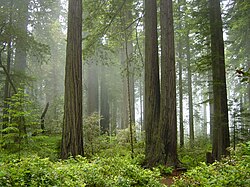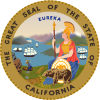North Coast (California)
This article needs additional citations for verification. (December 2008) |
North Coast
Redwood Empire | |
|---|---|
Region of California | |
 Coast Redwood forest in Redwood National Park | |
 The North Coast Region of the state of California | |
| Country | United States |
| State | California |
| Area | |
| • Land | 10,176.86 sq mi (26,357.9 km2) |
| Population | |
| • Total | 987,361 |
| • Estimate (2019)[2] | 1,003,281 |
| • Density | 99/sq mi (38/km2) |
The North Coast of California (also called the Redwood Empire[3] or the Redwood Coast) is the region in Northern California that lies on the Pacific coast between San Francisco Bay and the Oregon border. The area is named after the dense redwood forests throughout the region. It commonly includes Mendocino, Humboldt, and Del Norte counties and sometimes includes two counties from the San Francisco Bay area, Marin and Sonoma.
Cities[]
Much of the area is rural, and the only city within the region with a population of over 100,000 is Santa Rosa. Despite their relatively smaller size to the major cities elsewhere in the state, many of the region's cities and towns have historical importance to the State and/or regional importance.
County seats[]
- Del Norte: Crescent City
- Humboldt: Eureka
- Marin: San Rafael
- Mendocino: Ukiah
- Sonoma: Santa Rosa
Geography[]
The Pacific Ocean coast stretches from San Francisco Bay to Humboldt Bay and on to the border of Oregon. The coastline is often inaccessible, and includes rocky cliffs and hills, streams and tide pools. The coastline from Centerville Beach near Ferndale to the mouth of the Klamath River is mostly beach accessible and there are many small towns and a few cities along Highway 101, the main route through the region. The sparsely populated interior territory further inland is characterized by rugged, often steep mountains, bisected by rivers and their typically narrow valleys and canyons, and dense redwood, Douglas fir, and oak forests. The climate can range from coast side lands drenched with fog in mild winters and summers to inland reaches baked by hot sunshine on long summer days, which, at higher elevations, can be blanketed with snow in winter.

The southern portion of the North Coast is largely urbanized while the rest is mostly rural. The more remote northern areas are often referred to as being located "behind the Redwood Curtain."[4] A segment of the coastline in Mendocino and Humboldt Counties is known as the Lost Coast, and is only accessible by a few back roads.[5] Notable seaside beaches can be found at Marin Headlands and Point Reyes National Seashore in the south, with innumerable examples of remote or less used beaches north of the San Francisco Bay area.
The grandeur of the redwoods can be experienced throughout the region, from the protected groves of Muir Woods National Monument and Armstrong Redwoods State Natural Reserve in the south to the massive forests of Humboldt Redwoods State Park along the Avenue of the Giants in the north. Redwoods are also found in many other State and local parks, most of which are located along Highway 101 throughout the far North Coast. Other larger redwood parks include Prairie Creek Redwoods State Park, Del Norte Coast Redwoods State Park, Jedediah Smith Redwoods State Park and Redwood National and State Parks. In total, the redwood parks of the North Coast contain the vast majority of all remaining old-growth redwoods.
Demographics[]
| Historical population | |||
|---|---|---|---|
| Census | Pop. | %± | |
| 1860 | 23,855 | — | |
| 1870 | 42,429 | 77.9% | |
| 1880 | 68,146 | 60.6% | |
| 1890 | 89,466 | 31.3% | |
| 1900 | 104,159 | 16.4% | |
| 1910 | 133,711 | 28.4% | |
| 1920 | 143,720 | 7.5% | |
| 1930 | 175,347 | 22.0% | |
| 1940 | 200,380 | 14.3% | |
| 1950 | 307,197 | 53.3% | |
| 1960 | 467,917 | 52.3% | |
| 1970 | 576,296 | 23.2% | |
| 1980 | 715,718 | 24.2% | |
| 1990 | 841,241 | 17.5% | |
| 2000 | 946,193 | 12.5% | |
| 2010 | 987,361 | 4.4% | |
| 2019 (est.) | 1,003,281 | 1.6% | |
| Sources: 1790–1990, 2000, 2010, 2019[6][7][8] Chart does not include Indigenous population figures. | |||
2010[]
The 2010 United States Census reported that the North Coast region had a population of 987,361. The racial makeup was 771,611 (78.1%) White, 17,717 (1.8%) African American, 22,259 (2.3%) Native American, 37,461 (3.8%) Asian, 2,570 (0.3%) Pacific Islander, 91,107 (9.2%) from other races, and 44,636 (4.5%) from two or more races. Hispanic or Latino of any race were 197,308 persons (20.0%).[9]
Transportation infrastructure[]
Major highways[]
 Interstate 580
Interstate 580 U.S. Route 101 - Primary north–south route from San Francisco to Crescent City
U.S. Route 101 - Primary north–south route from San Francisco to Crescent City U.S. Route 199 - from U.S. Route 101 near Crescent City northeast to Interstate 5 at Grants Pass, Oregon
U.S. Route 199 - from U.S. Route 101 near Crescent City northeast to Interstate 5 at Grants Pass, Oregon State Route 1 - San Francisco to junction with US 101 at Leggett
State Route 1 - San Francisco to junction with US 101 at Leggett State Route 12 - from Sebastopol to San Andreas
State Route 12 - from Sebastopol to San Andreas State Route 20 - an east–west route ending at Fort Bragg
State Route 20 - an east–west route ending at Fort Bragg State Route 36 - an east–west route beginning at Alton, ending at Susanville
State Route 36 - an east–west route beginning at Alton, ending at Susanville State Route 37 - on the northern shore of San Pablo Bay
State Route 37 - on the northern shore of San Pablo Bay State Route 96
State Route 96 State Route 116
State Route 116 State Route 121
State Route 121 State Route 128
State Route 128 State Route 131 - (Tiburon Boulevard)
State Route 131 - (Tiburon Boulevard) State Route 162
State Route 162 State Route 169
State Route 169 State Route 175
State Route 175 State Route 197
State Route 197 State Route 200 - near Arcata, along the Mad River
State Route 200 - near Arcata, along the Mad River State Route 211 - Fernbridge to Ferndale
State Route 211 - Fernbridge to Ferndale State Route 222 - (unsigned)
State Route 222 - (unsigned) State Route 253
State Route 253 State Route 254 - (Avenue of the Giants - old U.S. 101)
State Route 254 - (Avenue of the Giants - old U.S. 101) State Route 255
State Route 255 State Route 271
State Route 271 State Route 283 - (old U.S. 101)
State Route 283 - (old U.S. 101) State Route 299
State Route 299
Related regions[]
Parts of these regions overlap parts of the North Coast:
- Emerald Triangle
- North Bay
- San Francisco Bay Area
- Wine Country
Regions contained entirely within the North Coast:
The North Coast region is completely contained within:
- Northern California
See also[]
- California's 2nd congressional district
- Central Coast (California)
- North Coast AVA
- South Coast (California)
- West Coast lumber trade
References[]
| Wikimedia Commons has media related to North Coast (California). |
- ^ "Annual Estimates of the Resident Population: April 1, 2010 to July 1, 2016 Estimates". Retrieved April 27, 2017.
- ^ "Population and Housing Unit Estimates". Retrieved December 3, 2019.
- ^ Rupprecht, Rich (November 6, 2008). "Primed for the Playoffs". The Press Democrat. The New York Times Company. Retrieved December 23, 2008.
- ^ Flinn, John (May 11, 2003). "Behind the Redwood Curtain: Humboldt a separate world of misty groves, offbeat towns and protected wildlife -- and one wild race". San Francisco Chronicle. p. C-1. Retrieved November 10, 2009.
- ^ "King Range National Conservation Area". Bureau of Land Management. Archived from the original on 2012-07-02. Retrieved 2013-07-07.
- ^ "California Grew By 356,000 Residents in 2013" (PDF). Archived from the original (PDF) on May 2, 2014. Retrieved September 26, 2016.
- ^ "1990 Census of Population and Housing, Unit Counts, United States, 1990 CPH-2-1" (PDF). Population and Housing Unit Counts, Population Estimates 1790–1990, pages 26–27. United States Census Bureau, U.S. Department of Commerce Economics and Statistics Administration. August 20, 1993. Retrieved January 1, 2012.
- ^ "California QuickFacts from the US Census Bureau". US Census Bureau. Archived from the original on December 28, 2009. Retrieved December 26, 2009.
- ^ "2010 Census P.L. 94-171 Summary File Data". United States Census Bureau.
- Regions of California
- Northern California

